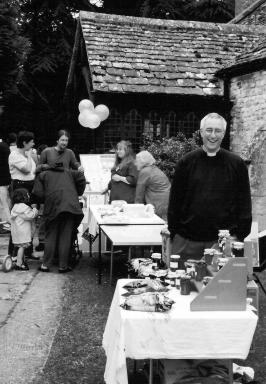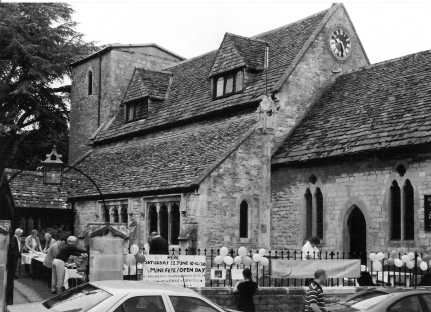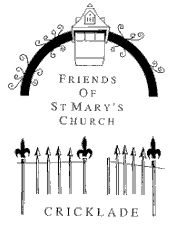


















 | |
Newsletter
No. 8
Summer
2002

|
|
Dear Friends,
£1500 in one week-end!
|
On behalf of the
organising committee of FOSMC, a big 'thank you' to everyone who
was involved in or supported the open day at the church in June.
Altogether from the fete, music evening a total of some £1500
was raised towards the continuing projects to restore and
improve the church.
The next event at the
church is on Saturday 14th September. That day, which
coincides with both the national Heritage Open Days (this year
on the theme of 'young people') and the Wiltshire Historic
Churches Trust sponsored cycle ride, the church will be open
from 10.30. St Mary's will be host to a meeting of the Young
Archaeologists Club (North Wiltshire branch). The YAC will be
investigating the church and its graveyard, and looking at how a
study of the building and its surroundings can help us to
understand the history of the town. |
 |
 |
| Preparations in full swing for
the June fete at St Mary's (left) and Fr Richard - with jam
stall - outside the porch (above) |
Opening up the North chapel -
voices from the past
During June 2002 the pipe organ at
St Mary's, dating to the late 19th century, was removed from
the North chapel. Bernadette Yarnold and Edmund Lee took the opportunity
to record the graffiti on the rear paneis of the organ, adjacent to the
North wall of the chapel. When it was originally built, the organ had to
be pumped by hand - the wooden handle originally used to pump the organ
was still in place. Beside, the wooden handle an indicator (presumably
of air pressure) moved between 'Empty' and 'Full'. Probably the task was
to keep the air pressure between these two extremes. The graffiti were
almost exclusively in pencil, with some use of yellow chalk. Most record
the names and initials of those who pumped the organ for church
services. It must have been a hard and repetitive task of in cramped,
dusty, dark (and very loud!) conditions. Many give dates, and these
range from 1906 (though this earliest date was not entirely clear) up
till the 1970's (again this latest is unclear) with most given dates
lying in the 1940's. Most just give a day, or year but some are more
specific - we now know who pumped the organ for the May 13th
1937 Rogation Service. Many local family names occur more than once,
suggesting that groups of children took on to this task (or were
persuaded!). Others had come from further afield - one 'Sydney W Dinely
RAF of Flixton nr Manchester' chose to leave his name - perhaps billeted
on a local family during the Second World War?. One contributor left a
poem:
'Here behind the organ I sit
and pump more and more
if my hand slips off the organ
handle, or,
if I do the splits its, just:
pack up me troubles in me old kit
bag
and smile smile smile'
Some years ago (does anyone
remember when?) an electric pump was fitted to the organ, and the
graffiti tail off, bringing to a close one chapter in the 'unofficial'
history of the church.
Removal of the organ has opened up
the North chapel. The foundations are believed to be the oldest part of
the building, and are on a different alignment to the rest of the
church. The space is now far more accessible and potentially useful. The
parish is now considering how best to restore this intriguing space for
use. Please do take the opportunity if you are in the church to have a
look - there is plenty that needs doing, not least to restore the arch
that connects the chapel to the North aisle, where the confessional is
sited. This is currently supported by timber bracing (possibly 1960's? -
does anyone remember when this was put in?) but a more structurally
sound solution is needed. This, and the work to restore the North wall
damaged by movement of the foundations will form the focus of
fund-raising and grant applications for some time to come.
Global Acclaim for the FOSMC
web-site
Our thanks to David Tetlow, who
has put together an excellent web-site describing the work of the
Friends of St Mary's Church, and making available much of the historical
research that has gone on over the last four years. The site can be
viewed at the following web address:
http://welcome.to/friendsofstmarys
Since its launch, more than 1600
'virtual' visitors have learnt more about the church and its history,
and David's site has won several awards from local organisations, church
internet sites and genealogists. In the last few weeks I have been
contacted by one correspondent who found out about Friends of St
Mary's via the web. He was writing
from Grand Rapids, Michigan, in the USA, looking for details of his
ancestor, one Alfred Fawkes Herring, born in Cricklade c.1834. If
anyone has details, or might be related, I'd be happy to put you in
touch - let me know. All told, David has provided us with a site to be
proud of.
A date for your diaries - the Friends AGM
Please note that the Annual General Meeting of the Friends,
open to all members, will be held this year at 7.30 p.m. on November
12th (after 7 p.m. Mass at St Mary's). The venue
and further information will be sent out nearer the time. |
|
| Friends
of St Mary's Church Newsletter - Special Supplement - Friends of the
Friends

A
Profile of David Apperley
| As well as raising money and
organising events, the Friends of St Mary's is there to celebrate
the contribution made to the upkeep of the church over the last
twenty or so years by many individuals. David Apperley, who has
maintained the churchyard, and wound the clock at St Mary's for
many years, kindly agreed to be interviewed for the first of what
hopefully will be an occasional series of recollections about the
church and the community in Cricklade. [Ed]
David was born in Cheltenham in 1937, and first went to school
there at St Mary's Convent, now St. Edwards. His father was in the
RAF and when he was posted overseas it was decided that
David would go to Prior Park boarding school, then based in Bath.
He had been there for one term when the Manor House in Cricklade
was bought for the school and the youngest thirty boys, including
David, moved to the new Prior Park school in Calcutt Street,
Cricklade.
Before its purchase by the school, the Manor had been very
homely. David remembers an indoor 'garden room' upstairs with two
swings and all the walls painted as flowerbeds. The painting had a
three dimensional quality and was very real. This indoor garden
room was left for years until it had to be painted over, having
fallen into disrepair. The room now used as the school library was
then the school chapel. Some pews for this chapel were given by
the vicar of St. Sampsons. When David was seven he helped moved
these pews from St. Sampsons to the Prior Park chapel - it took
about twelve boys to carry each pew. Smiling, David recalls how,
twenty years later, he helped move these pews again from Prior
Park to St. Augustine's Chapel (now the Museum) after Cricklade's
Catholic community had purchased St. Augustine's. David boarded at
Prior Park as in those days there were no day places. Joan O'Leary
taught him and his two brothers. Nurse Kelly, also a long-standing
member of the Cricklade Catholic community, cared for them and
particularly remembers his youngest brother. David remarked how
this continuity and 'connectedness' was really nice: "There
is almost a family ready and waiting in Cricklade," he said.
From school, David became an engineering apprentice. He did
national service in the R.A.F during 1958 - 1960, serving on the
east coast at Coltishall, near Norwich and Yatesbury near Calne.
He |
felt that National Service was a
terrific opportunity for young men to broaden their horizons,
especially if they had not been away from home before. He was
seconded to the Navy where he learned about guided missiles. He
and some others were posted to Australia with only three months
left to serve. They got to Germany and then were sent back when
this was realized.
Father O'Donnell of St. Peter's, Cirencester bought the former
Baptist Chapel of St Augustines at auction in the early 1960s. In
those days the Baptists were not eager to sell the Chapel to
Catholics and so someone else bought it on the behalf of the
Catholic community in Cricklade. The neighboring cottage on the
High street side of the Chapel had to be purchased as well as the
chapel and the purchaser had then to demolish this cottage as it
was unsafe. The cottage cost £225-00 and the chapel cost
£302-00.
For some years after, a parishioner, Mr Bourne, cut the grass
at St. Augustine's. One day Father O'Donnell said to David
"You live quite close, do you have a lawn mower?" This
was in 1975 and David said "I don't mind doing it for a few
weeks." He's been cutting the grass and taking care of the
grounds first at St. Augustine's and then at St. Mary's ever
since.
As that first summer came David remembers the brambles getting
higher and higher around St. Augustines and he noticed that they
were starting to push over the chapel wall, so he reduced the
weeds and created an allotment and grew vegetables there with John
Petrie of Hopkins Orchard. He remembers local people being pleased
as the weeds had gone and on them remarking how neat it looked.
"It grew on you," he says, recalling the work involved
in keeping the guttering clear and the windows repaired. (Other
parishioners remember when light bulbs went in the Chapel Father
would mention it to David and quietly and quickly David would
replace each used bulb with a new bulb of good quality. One day it
wouldn't be working and the next there would be light. Older
parishioners remember David and his wife being fond of ballroom
dancing and on Holy days of Obligation David would sometimes come
to mass in his evening suit rather than miss mass). There was
large congregation at St. Augustine's. David recalls it being
quite full. Prior Park school was run until the 1980's by the
Christian Brothers, a |

| teaching order based in Liverpool. They
acted as sacristans and kept the Host in Prior Park chapel. In St.
Augustine's there were four electric heaters which were put on at
7.00 o'clock in the morning ready for Mass, although even by 9.00
o'clock it was barely warm.
At St. Augustine's David lifted all the gravestones and placed
them along the wall of the chapel as some of the gravestones were
leaning badly. First he put up a notice to see if there were any
objections and to let the relatives of those interred here know of
his intentions. No one objected and, as David was doing shiftwork
at this time in Swindon at Metalbox, he was often there for part
of the day and people seemed to be quite pleased that the
gravestones should be nice and tidy.
Father McGlinchey was eager to purchase St. Mary's when it came
up for sale in the early 1980.s. It was advertised "For sale
or let as a Warehouse." David kept this hand-painted sign
feeling it to be important one day as a part of St. Mary's
history. David remembers the people of the town being so pleased
St. Mary's was saved from being a warehouse - "our own little
reformation." Father O'Donnell was concerned whether it would
be financially possible, whether the Catholic community could
afford the initial repairs needed. Fortunately Father McGlinchey
was a gifted fundraiser. David reflects how extraordinarily lucky
the Catholic community in Cricklade has been to have the gifts of
so many people and priests, always at the right time too. The
Bishop came to the opening of St. Mary's in 1984.
David transferred his mowing. Before the Catholics took over
there were only two services in St. Mary's a year and the weeds
had got very high, waist high in fact with an eight foot buddleia
etc. Rev. Ken Withington agreed with the Town Council for there to
be a bit of a project where the Rangers came and cleared a lot of
the weeds so it was now possible to at least walk around and for
David to get his mower in. Ken Withington said the only thing he
would miss from this whole affair (he lived next door) was the
loss of the log shed. This was an air raid shelter that had been
built into the Church. It had a roof of concrete, stone walls and
a wooden door. Moore's the builders demolished it. (Possibly it
had been a pillbox, being in a good strategic position with a
square loophole overlooking North bridge - Ed). At this time St.
Mary's' interior smelt like an old car and smiling, David recalls
if every member of the congregation had sneezed at the same |
time all the plaster would have fallen,
it being that crumbly.
Everyone was very keen to get St. Mary's clock going. Joe
Robinson, the father of John Robinson the plumber in Cricklade had
wound the clock from the age of fifteen until seventy- three when
he could no longer climb the ladder into the tower. Joe Robinson
warned David about the danger of over-winding the clock. David
remembers gingerly winding the clock, the weights crashing and
there being a clang as the wire parted. Paul Linsey, a member of
the congregation who worked at RAP Lyneham, got some aircraft
cable to replace the broken wires. David scrubbed, sprayed,
cleaned and oiled the clock. There were a few 'teething problems'
- on one occasion the clock was over wound, sheering the brass
teeth off. The apprentices from RAF Lyneham again came to the
rescue. 1985 -1986 there is a photograph taken by Mr. Giles wife
(they lived opposite the church) of David and Peter Baister
standing on the apex of St. Mary's roof as they removed the clock
face for repainting at RAF Brize Norton in one of the paint shops
there. David remarked how important the Catholic community is to
the town.
Whilst cutting the grass at St. Mary's, often of a Saturday,
David really enjoyed opening the church for visitors - getting the
key first from Blackwells and then from Beryl's Florists in the
High Street. Mr Ramsden Binks told David about the Sundial on the
church wall near the cross and how people used to put pegs in the
holes in the wall to denote church service times. David keeps the
hedge quite high in St. Mary's church yard where it adjoins
neighboring properties, partly as a protection for the neighbors
(as Blackwell's had all their gas bottles stolen when the hedge
was cut quite low) and partly to give neighbors their privacy,
which in turn enhances the tranquillity of St. Mary's churchyard.
One last thought as David was leaving: "Don't write
anything too glowing about me - I only mow the grass. "
|
|
|



